
|

|
| Background | Hypotheses | Bibliography | Maps | Home |

|

|
| Background | Hypotheses | Bibliography | Maps | Home |
Fish Disease in the Noyo River
KRIS Web Background Pages: Fish Populations
![]()
Fisheries data in KRIS Noyo comes from several sources, including the California Department of Fish and Game (CDFG), the California Department of Forestry (CDF) and Mendocino Redwood Company (MRC). Types of samples include net sampling, electrofishing, dive observations, downstream migrant trapping, and adult counts of coho salmon and steelhead adults at the Noyo Egg Collecting Station (see Hatchery Data in KRIS Noyo). In addition, regional data regarding coho salmon presence and absence has been captured for use in KRIS from Adams et al. (1999) and Brown and Moyle (1994) range.
The earliest known fish samples from the Noyo Basin come from 1966 reports by CDFG staff. The KRIS Bibliography allows full review of 28 CDFG stream surveys from the Noyo Basin, conducted in the years 1957,1959,1966-67. Net samples during 1966-67 surveys were taken in ambiguously defined reaches. No detailed information is available on the type of nets used or the types of habitats sampled. Consequently, these data are used only to show a rough balance between coho and steelhead in the various basins and the former distribution of coho. These "baseline" samples are being compared more recent data to gauge changes over time in fish community structure. Maps are also being prepared to show the changes spatially and temporally. CDFG has used seine nets to sample fish in the lower Noyo River and estuary, but sampling was not extensive and no reports are available at this time.
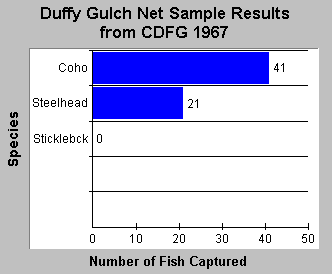 |
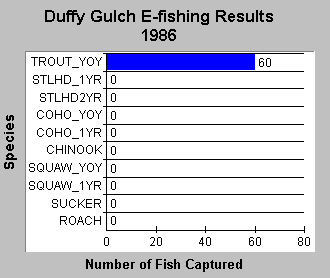 |
| Net samples of Duffy Creek in 1967 had more coho salmon than steelhead. Details on sampling are not available but the data suggest that coho were more abundant, relative to steelhead, at least in some habitats at the time of the survey. According to the survey, Duffy Gulch "provides the Noyo River system with 1.05 miles of good spawning grounds and 1.75 miles of fair nursery area." Pools constituted an estimated 30% of habitats. | Electrofishing samples by CDFG in Duffy Gulch in 1986 did not capture any coho salmon. These data cannot be interpreted to mean that coho were or are absent from this drainage. |
Electrofishing data in KRIS Noyo are of two types. Some data are collected at a reconnaissance level during habitat typing surveys while other more intensive methods provide more quantitative information. When fish surveys were done in conjunction with habitat typing, no block nets were used and no attempt was made to calculate the population of juvenile salmonids. KRIS Noyo uses this type of data as a snap-shot of community structure with the change in the mix of coho and steelhead taken as an indicator of habitat change and suitability.
These data must be used with the qualification that absence in such samples does not mean that a species is not present in the entire stream in other years or even at the time of the survey. Also, some species, such as chinook salmon, may not have an extended freshwater life history and would not be expected to show up in samples taken during summer and fall.
Shown below are CDFG electrofishing data from an index reach of Pudding Creek, where block nets were erected and samples conducted with equal effort each year. Burns (1972) and Valentine (1994) used similar methods in the Little North Fork Noyo River to gauge densities and biomass per unit area. While coho biomass seems to have decreased substantially, steelhead biomass has shown an increase. (See Hypotheses #1 and #2 for analysis). MRC uses direct dive observation, block nets with electrofishing, and quantitative sampling in streams reaches within their holdings. The surveys are used to gauge distribution of various species of salmonids, and in some cases calculate densities in specific areas. Other vertebrate species captured are also noted.
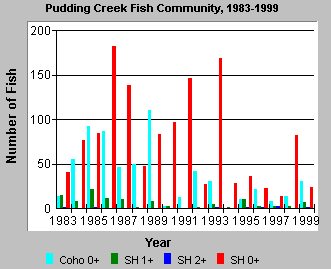 |
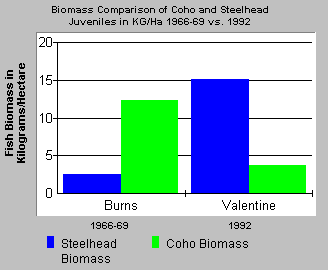 |
| This chart shows the number of fish captured in electrofishing samples of similar reaches in Pudding Creek from 1983 to 1999. The data show changes in standing crops of juvenile salmonids and other fish over time. Coho and steelhead of all age classes have decreased. | This chart shows the biomass of steelhead and coho salmon juveniles in kilograms/hectare from two different study periods on the Little North Fork Noyo River. Burns (1972) and Valentine and Jameson (1994) both used electrofishing to sample extensive reaches. Burns sampled in 1966, 1968 and 1969 and the Burns values above represent an average of all three years. Valentine sampled only in 1992. |
Downstream migrant trap data provide a much better sampling method for gauging fish community structure. Traps are operated for several months and fish are measured as they are counted. Data reveal migration timing, size and age and species composition. The traps in the South Fork and North Fork South Fork Noyo River do not capture the entire stream flow and have not been calibrated to allow extrapolation and calculation of populations. KRIS Noyo also has downstream migrant trap data from the Little North Fork Noyo River, which was gathered as part of joined effort by the local community and for a Humboldt State University Master Thesis (Maahs, 1996; Manning, 2000). Sampling methods were similar to those used by CDFG.
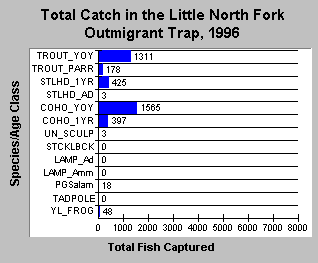 |
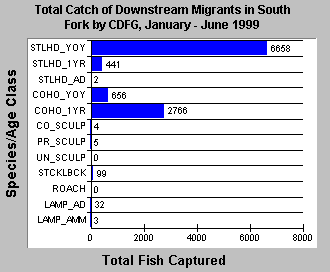 |
| David Manning of Humboldt State University operated a fyke net in the Little North Fork Noyo River for the spring seasons of 1995 and 1996. The Little North Fork produced about an equal number of steelhead and coho juveniles during the trapping season of 1996. Disparity between the standing crop estimate by Valentine and Jameson (1994) which shows steelhead dominance in eletrofishing samples could be the result of different out-migrant timing. Many steelhead may migrate downstream in fall and winter when the downstream migrant trap is not in operation. | The SF Noyo River downstream migrant trap, operated by CDFG, shows that this watershed produces coho salmon and steelhead trout, including a considerable number of yearling steelhead. The South Fork Noyo River coho population is also enhanced by the smolt releases from the Noyo Egg Collecting Station. The ratio of hatchery and wild coho is unknown. |
The charts below show the findings of field surveys to determine the presence or absence of juvenile coho salmon in streams throughout the Central California ESU, which extends south of the Mattole River to Santa Cruz, including some San Francisco Bay tributaries. The loss of coho salmon from tributary basins and portions of large rivers shows fragmentation of the distribution of coho which is a warning sign for decline toward extinction. Noyo River presence data may be influenced by hatchery operation. Absence data is provisional pending because streams have not been surveyed in three consecutive years and coho may be present in some years but not others when year classes fail.
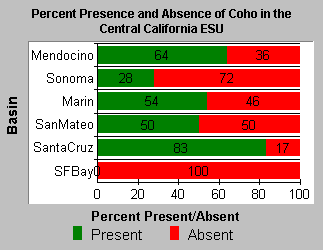 |
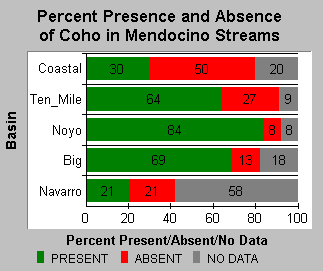 |
| In Mendocino County, 36% of the streams lacked coho, while coho were absent from 72% of Sonoma streams. Absence data is provisional pending more extensive study because coho may exist in some streams but only occur in some years because of complete losses of year classes. Data are from Adams et. al.(1999). | The chart above shows the presence or absence of juvenile coho salmon in Mendocino coastal streams in the early 1990s as presented in Brown et al. (1994). Coho were missing from 50% of the small tributaries that drain directly to the Pacific Ocean (Coastal), 27% of Ten Mile River tributaries surveyed, 8% of Noyo River tributaries and 21% of Navarro River tributaries. Tributaries known to harbor coho in the past but not surveyed are shown as NO DATA above. |
![]()
References
Adams, P.B., M.J. Bowers, H.E. Fish, T.E. Laidig, and K.R. Silberberg. 1999. Historical and Current Presence-Absence of Coho Salmon (Oncorhynchus kisutch) in the Central California Coast Evolutionarily Significant Unit. National Marine Fisheries Service, Southwest Fisheries Science Center. Administrative Report SC-99-02. 24 pp.
Burns, J. 1972. Some Effects of Logging and Associated Road Construction on Northern California Streams. Transactions of the American Fisheries Society, Vol. 101, No.1: 1-17.
Brown, L.R., P.B. Moyle, and R.M. Yoshiyama. 1994. Historical Decline and Current Status of Coho Salmon in California. North American Journal of Fisheries Management. 14(2):237-261.
Maahs, M. 1996. 1996 South Fork Ten Mile River and Little North Fork Noyo Out-migrant Trapping. Final Report. Prepared for Humboldt County Resource Conservation District. 43 pp.
Manning, D.J. 2000. Carrying Capacity and Limiting Habitat Analysis for Coho Salmon (Oncorhynchus kisutch) in Streams of Northwestern California. Masters Thesis, Humboldt State University, Arcata, CA. 111p.
Valentine, B.E. and M. Jameson. 1994. Little North Fork Noyo Fishery Study, 1992. CA Department of Forestry and Fire Protection, Coast Cascade Region. Santa Rosa, CA. 48 pp.
![]()
| www.krisweb.com |